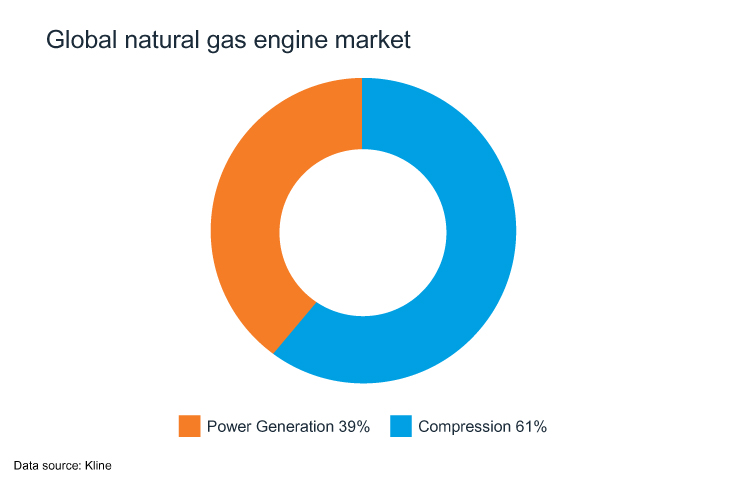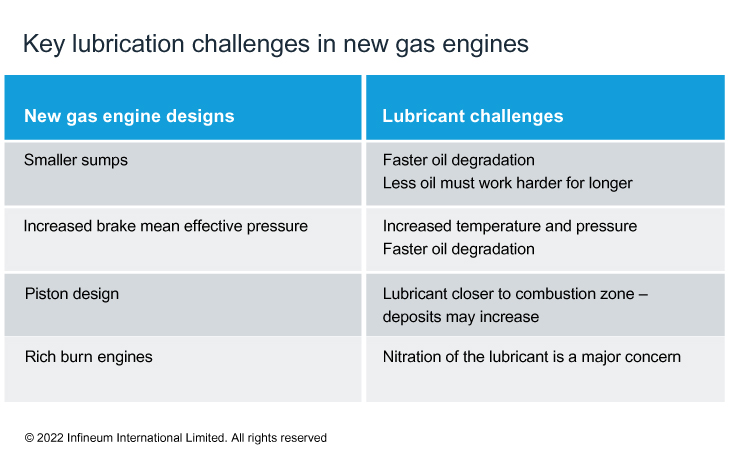Gas Engines
Smooth operation for over 90,000 hours
28 August 2024
18 January 2022
Natural gas engine oils must be designed to deliver protection non-stop over longer drain intervals

The lubrication of gas engines comes with a long list of challenges including their remote locations, continuous operation and harsh conditions. Insight explores how gas engine oils need to be formulated to ensure they continue to deliver sufficient hardware protection over longer drain intervals to ensure maximum up-time while also helping to reduce maintenance costs.
Stationary natural gas engines are typically used to carry out two main jobs: power generation and gas compression. Despite the dip in demand for energy during the COVID-19 pandemic, global demand now looks set to increase out to 2050. And, although heightened environmental concerns mean that in some markets there is a growth in the use of renewable energy sources, the demand for gas also looks set to grow. Here forecasts suggest that demand for gas from price sensitive markets in Asia could account for over half of incremental global gas consumption in the coming years, driven principally by the development of gas in China and India.
IEA suggests that by 2024, global demand will be up 7% from 2019’s pre-Covid levels.
This means more gas will need to be moved from wellhead to the consumer – something that is facilitated by the use of natural gas compression engines. These enable gas to be compressed to a smaller volume at any stage of the value chain, including gas lift, gathering, wellhead gas compression, pipeline compression, transportation, storage, gathering, and re-injection. The global gas engine market is highly skewed by the large and growing North American gas compression market, where engines are predominantly used for gas production, pipeline and storage.

The compression market is concentrated in North America while the power generation market is fragmented
To meet regulatory pressures to reduce greenhouse and other emissions, OEMs have developed high efficiency engines and increased the use of aftertreatment devices. At the same time, OEMs are mindful of customer requirements for increased engine reliability over longer periods to reduce maintenance and engine downtime and for higher efficiency to reduce running costs and increase output. These requirements prompted the evolution of more efficient and higher power density engines with consequent higher temperatures, higher pressures and higher stresses, all of which put increasing demands and challenges on the lubricant.
In gas compression applications, one of the biggest challenges is that most engines operate non-stop, at high capacity in very remote locations.
This means that natural gas engine oils (NGEO) must reliably deliver sufficient hardware protection throughout their lifetime in the engine. There is no room for compromise. And, this task is made more difficult as sumps get smaller, which means oils can degrade faster and yet consumers are demanding longer oil drain intervals to reduce maintenance and downtime.

Meeting all these challenges is made even more challenging as chemical constraints increase. For example, lower sulphated ash to ensure compatibility with engines and aftertreatment systems from all major OEMs and low phosphorus for catalyst compatibility.
Despite these challenges, there are currently no industry-wide gas engine oil standards and drain intervals are generally determined by in-service testing of a number of parameters. Many end users change their oil based on OEM recommended requirements for oil condemning limits. What this means in practice is that they must have absolute confidence that the oil will continue to do its job beyond the standard service maintenance period. If oil drains have to be shortened, the engine is forced out of service sooner than envisaged to allow an unscheduled oil drain or preventive maintenance to be carried out – increasing running costs and downtime.
However, in remote compression applications, gas engine oil changes may be scheduled based on technician availability. Here if oil degradation occurs sooner than expected it could mean damaged hardware and an even longer downtime.
It is vital for gas engine oils to be capable of delivering the required performance over the expected drain interval to help keep utilisation rates up and running costs down.
Infineum has been working to develop carefully formulated next-generation lubricants, with the right balance of additives and high quality base stock to help prevent, or at least slow down, the process of NGEO degradation in these latest engines.
To ensure the performance of new formulations it is vital to test them in real-world operating conditions in the latest available hardware. Some OEMs have introduced lubricant approval processes that include both chemical and physical testing and extensive field trials to help ensure their engines are sufficiently protected over the required drain interval. INNIO Waukesha is one such OEM and Infineum set out to gain their approval for its latest NGEO formulation.
The field trial, run in accordance with the INNIO Waukesha oil approval procedure and inspection guide, was carried out over 4,000 hours in an INNIO Waukesha 7044 GSI gas engine running 24/7/365 at a very remote site in extreme conditions.
The field trial has now finished and initial findings show the oil delivered a high level of cleanliness and deposit control over the entire test duration.
In addition, the oil gave exceptional nitration resistance compared to other oils tested meaning extended oil drains are a true reality for rich burn INNIO Waukesha gas engines.
In the next issue of Insight we will bring you the full results and a video of this extensive field trial.
Sign up here to receive an email notifying you when the article is live.
Sign up to receive monthly updates via email